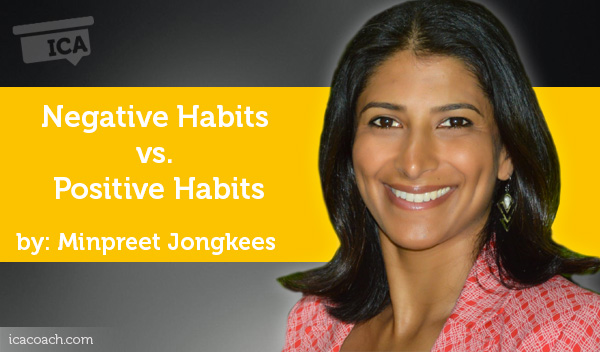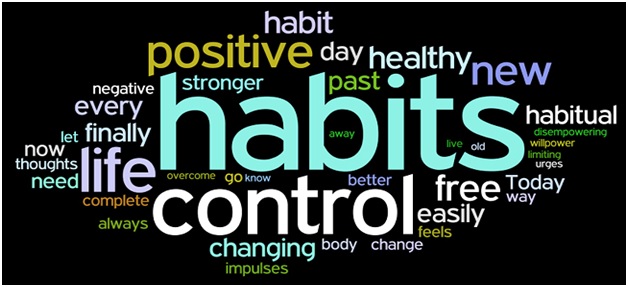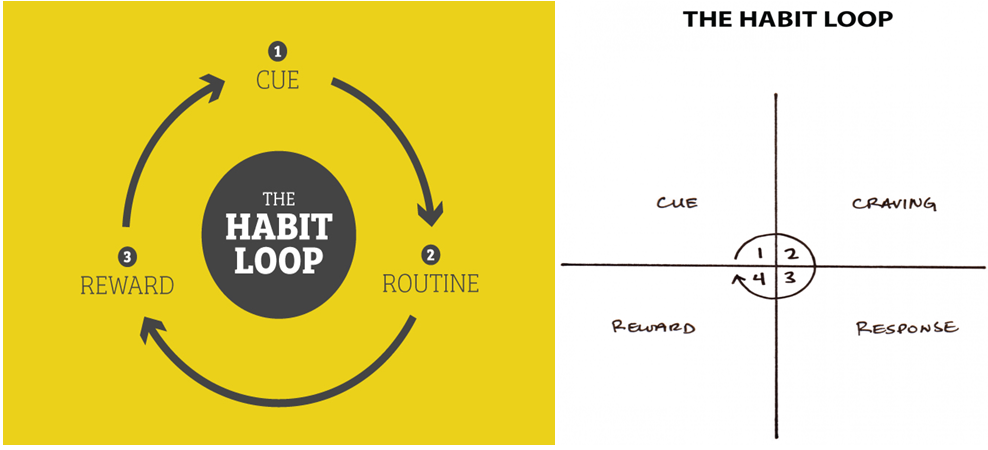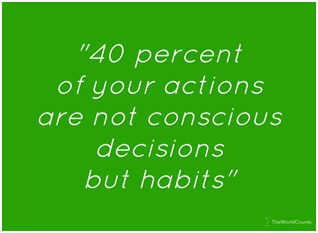
A Coaching Power Tool Created by Minpreet Jongkees
(Health Coach, AUSTRALIA)

Many of us would like to change or even eliminate what we consider negative habits from our lives. They don’t serve us, don’t bring us happiness and some are unhealthy and yet, we just can’t “kick the habit”! First of all its important to understand what a habit is and how a habit is formed. Only then can we begin to appreciate what is needed to change habits from negative to either positive habits or eliminate them altogether. You’ll soon see that this is an “easier said than done” situation, and is exactly where a Coach can facilitate and support the Client to increase the chances of success in changing negative habits to positive ones.
What are Habits?
Habits are repeated behaviours that require little to no conscious thought. An example of this is switching on a light in a dark room or attempting to catch an unexpected ball thrown in your direction, or carrying out morning routines. Repeated behaviours result in habit formation which can be either beneficial or detrimental to people mentally, physically and/or socially. These repeated behaviours eventuate into habits, these habits often occur without any real intention or thought given to them.
Humans really like to achieve maximum results for minimal effort, we are designed to meet our basic needs using as little energy as possible. We are wired to be this way, and this is where our established habit’s “home” is. Deeply rooted in the brain in the Basal Ganglia. There have been cases where severely brain-damaged patients have been able to carry out basic needs (habitually), in one such case a Patient was able to satisfy a hunger cue by getting up and going to the kitchen to find food. However, when asked later on if he could point to the kitchen, he was unable to do so.
In 1990, researchers at MIT confirmed that habits are indeed created to save brain effort and energy. They had mice try to find a piece of chocolate at the end of a t-shaped maze. The time it took for the mice to find the chocolate was measured and repeated over and over again. Eventually, the mice found the piece of chocolate faster and faster because they learned where the chocolate was and memorised how to get it. Surprisingly the researchers found that the brain activity of the mice over time decreased. This is known as “chunking” and is at the basis of all habit formation. This process is important in allowing the brain to save energy whilst carrying out common tasks efficiently. In the case of the mice, a complicated and difficult task at first eventuated into an effortless task with repetition. Other research in 2006 suggested that as many as 40% of our daily actions are carried out habitually.
In order to save us more energy and effort habits are also able to take that efficiency beyond just our basic needs. Take driving a car for example. To start with it is difficult to remember which is the clutch, brake, accelerator with our legs, with the added addition of the arms, one hand to change through the gears, another to indicate, turn on the wiper/lights, all whilst holding the steering wheel and stay on the correct side of the road! Having a conversation during this early behaviour development is almost impossible. However, after years of practice, we do all of the above plus can participate in a detailed conversation. This is the result in habit formation that has been created in order to make the act of driving a vehicle an automatic and subconscious behaviour resulting in getting from A to B whilst expending minimal energy and effort.
How are Habits formed?
Habit formation starts early, an example would be a newborn baby crying because it’s hungry which results in it being fed and feeling satiated. This habit formation carries over into adulthood, some habits alter and can completely change when the environment is altered, such as moving away from home for the first time, moving countries or meeting a new Partner.
So how are these habits created? Charles Duhigg’s 3 loop habit loop is the core base. The cue – routine – reward loop forms the basis for all other models which some e.g. Nir Eyal and James Clear have added in an extra step. Although all three recognise that “craving” is an important part of the loop, Duhigg left it out, but with further research, it has now been added to the loop, as James Clear illustrates below. The following are the 4 stages of the Habit Loop, part extracts from James Clears Book “Atomic Habits” explains nicely the 4 stages of the Habit Loop.
-
Cue:
First, there is the cue. The cue triggers your brain to initiate a behaviour. It is a bit of information that predicts a reward. Our prehistoric ancestors were paying attention to cues that signalled the location of primary rewards like food, water, and sex. Today, we spend most of our time learning cues that predict secondary rewards like money and fame, power and status, praise and approval, love and friendship, or a sense of personal satisfaction. (Of course, these pursuits also indirectly improve our odds of survival and reproduction, which is the deeper motive behind everything we do.)
-
Craving:
Cravings are the second step of the habit loop, and they are the motivational force behind every habit. Without some level of motivation or desire—without craving a change—we have no reason to act. What you crave is not the habit itself but the change in state it delivers. You do not crave smoking a cigarette, you crave the feeling of relief it provides. You are not motivated by brushing your teeth but rather by the feeling of a clean mouth. You do not want to turn on the television, you want to be entertained. Every craving is linked to a desire to change your internal state.
-
Routine/Response:
The third step is the response. The response is the actual habit you perform, which can take the form of a thought or an action. Whether a response occurs depends on how motivated you are and how much friction is associated with the behaviour. If a particular action requires more physical or mental effort than you are willing to expand, then you won’t do it. Your response also depends on your ability. It sounds simple, but a habit can occur only if you are capable of doing it.
-
Reward:
Finally, the response delivers a reward. Rewards are the end goal of every habit. The cue is about noticing the reward. The craving is about wanting the reward. The response is about obtaining the reward. We chase rewards because they serve two purposes: (1) they satisfy us and (2) they teach us.

James Clear’s revised 4 step Habit Loop is a build on from Charles Duhigg’s 3 steps Habit Loop.
What are positive and negative habits and how do they serve us?
How many times have you tried to “kick a bad habit” only to find yourself unsuccessful merely days or weeks later? What flood of negative emotions followed that ‘failure’? I’m guessing it’s not a pretty picture. Negative habits stagnate our growth. Not only just within ourselves (mentally and physically), but also our relationships. For example, the inability to quit smoking (after countless attempts) takes its strain not only on the individual trying to quit, but also their loved ones and their closest network. This one detrimental habit can have many negative outcomes, such as strained relationships, divorce and death. Yet, this negative habit is one of many that people are “stuck” with. How does one change their habits, and how can Coach support and facilitate this change?
There are countless books (The 7 habits of highly effective people, High-performance habits to name a few) that encourage people to think and develop more positive daily habits in order to live an effective, purpose-filled, efficient life. Having a day full of positive habits is almost a dream for many people: exercise daily, sleep 8 hours per night, less social media, less screen time, strengthening/creating relationships, make healthy eating and drinking choices, be more productive at work and home etc etc. If we were able to establish all of our “wish list routines” into positive habits, we would be living a full and optimal life. The people who do reach this level of living are often the envy of many other people, a perfect example of this is Richard Branson co-founder of Virgin and Billionaire. However money, success and fame are not the focus here, the Tibetan Monks are equally living an optimal life full of positive habits and for the purpose of only looking at established positive habits that are self-fulfilling, then the Monks are comparable to Richard Branson. Point being, who you are doesn’t matter, what you are doing daily subconsciously does.
How can Negative Habits be changed into Positive Habits?
We now know what habits are, and how some habits serve us better than others. However, how can habits be changed? How do we make more positive habits in our lives, and eliminate or replace the negative habits we currently have?
First, we start with the core of a habit. All behaviour is driven by the desire to solve a problem. Therefore the purpose of every habit is to solve the problem. If we go back to Steve Clear’s 4 stage Habit Loop the loop can be broken down into two phases of Habit Formation. Stage 1: Cue and Stage 2: Craving is the PROBLEM phase of the Loop. Stage 3: Response and Stage 4: Reward is the SOLVING phase of the Loop. A common habit example is PROBLEM PHASE: Cue: You wake up. Craving: You want to feel alert. SOLUTION PHASE: Response: You drink a cup of coffee. Reward: You satisfy your craving to feel alert. Therefore the Habit is: Drinking coffee becomes associated with waking up. This process in your mind is conducted within milliseconds and over time the neural pathways are strengthened and this becomes a habit very difficult to break. Using this as an example, it is obvious to see that the cue is waking up. However, for many habits, we are aware of the outcome of the habit, but not necessarily aware of what the cue is. Practising mindfulness is an important and helpful start in exploring what the possible cue is in your negative habit that you wish to change. Becoming more self-aware is the base and beginning. From there, James Clear suggests 4 laws to creating new habits and 4 inverse laws to breaking habits.
STAGE MAKING HABIT (Laws) BREAKING HABIT (Inverse Laws)
Cue Make it obvious Make it invisible
Craving Make it attractive Make it unattractive
Response Make it easy Make it difficult
Reward Make it satisfying Make it unsatisfying
Initially, it can be tackled with taking smaller steps and start with simply swapping different responses to create a more positive reward, and thus altering the habit from a negative to a positive habit. Below is an example I stumbled upon myself.
Mini Case Study (Myself)
Writing this power tool was just not happening. I was allowing myself the time, rescheduling my diary and prepared my environment for no distractions. Allowing myself at least an hour + a day to get through this. However, it wasn’t happening. Every day I wasn’t writing was another day of frustration. Coincidentally (or not), I had started an 8-week Mindfulness Based Stress Reduction course. It was during one of my wayward thoughts during meditating that I had an epiphany. As a student many years ago I suffered from procrastination when it came to writing assignments and exam preparation. Often leaving it all to the very last minute. To cope with the late nights and early morning wake ups I developed a habit of snacking on m&m’s and drinking energy drinks to power me through to the end. Back to my current reality, I am in the middle of a fitness challenge, on a very restrictive diet, training hard and to be honest burning the candle at both ends. Limited on energy, I decided to give my old habit a go. Sure enough, I sat down with a bowl of cooking chocolate (only chocolate I could find in the house) and managed to get well underway. I was blown away. Suddenly I felt lighter as the heaviness lifted off my shoulders. However, slowly creeping in was regret for not staying on track for my fitness challenge. Using James Clear’s model my habit was: Snacking on chocolate which became associated with writing assignments. Taking advice from Charles Duhigg’s book “The Power of Habit”, I decided that a small step and change was better than eliminating this habit, as I still wanted to feel productive and finish this assignment. Change: I prepared a platter of fruit and carrot sticks to help “fuel” my habit with a positive twist. To my surprise, it worked. I wasn’t really getting the energy from the food, it was purely the habit of mindlessly picking up food and eating whilst typing and thinking that gave me satisfaction. Simply put, I broke down my habit, accepted it was there, made one simple change, and I ended up with a result that I was content with. No I didn’t eliminate my habit, but I didn’t feel it was necessary to do so, however, I was able to change it from a negative habit to a positive response and the reward was still satisfied.
How can Coaching support Habit Change?
Being coached throughout this process can have an impact on the success rate of changing or eliminating habits. Research done on AA members with a support partner showed a higher success rate than AA members without a support partner. Having an accountability partner is a powerful asset to someone changing or eliminating habits. Coach skills in active listening and posing powerful questions can further support the Client in understanding why and what they are trying to change. Long-term habits are ingrained deep in our brain in the Basal Ganglia and these neural pathways continue to exist even when a new positive habit is formed in place of a negative habit. Which means Clients are at a high risk of relapsing back into their old negative habit. This is a fact, a small simple trigger (cue) can set them back into an old habit, so it is important that Client fully understands their negative habit and the cues in which triggers the negative action/response. This is where Coaching can really support a Client. If they relapse, active listening skills and presence will be key in allowing the Client space to break down what went ‘wrong’, and explore how they can move forward hopefully having learnt what the cue was that triggered them. It’s important to note that the actual cue can often be quite different to what the Client thinks the cue is, its a trial and error process which has the ability to carry a lot of emotion for some.
Some Habit focused Coaching Questions could be:
Finally, I’ll leave you with a little piece of interesting information. How long does it take to form a habit? 21 days, 60 days, 100 days? The answer is anywhere from 18 to 254 days dependant on the behaviour, the person and the circumstances. What about how long it takes for a new behaviour to become automatic? On average 66 days, just over 2 months.

References and Resources (Books)
“The Power of Habit” by Charles Duhigg
“Hooked” by Nir Eyal
“Atomic Habits” by James Clear
“Triggers” by Marshall Goldsmith and Mark Reiters
“Making Habits, Breaking Habits” by Jeremy Dean
“Rewire” by Richard O’Connor
“Mini Habits” by Stephen Guise